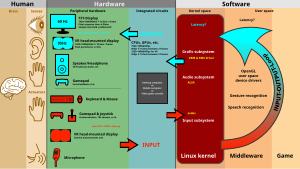Peripheral
This article needs additional citations for verification. (May 2015) |

A peripheral is a "device that is used to put information into or get information out of the computer."[1]
There are two different types of peripherals: input devices, which interact with or send data to the computer (mouse, keyboards, etc.), and output devices, which provide output to the user from the computer (monitors, printers, etc.). Some peripherals, such as touchscreens, may combine different devices into a single hardware component that can be used both as an input and output device.
A peripheral device is generally defined as any auxiliary device such as a computer mouse or keyboard that connects to and works with the computer in some way. Other examples of peripherals are image scanners, tape drives, microphones, loudspeakers, webcams, and digital cameras. Many modern devices, such as digital watches, smartphones and tablet computers, have interfaces that allow them to be used as a peripheral by desktop computers, although they are not host-dependent in the same way as other peripheral devices.
Common input peripherals include keyboards, computer mice, graphic tablets, touchscreens, barcode readers, image scanners, microphones, webcams, game controllers, light pens, and digital cameras. Common output peripherals include computer displays, printers, projectors, and computer speakers.
See also
- Computer hardware
- Controller
- Display device
- Expansion card
- Input device
- Output device
- Punched card input/output
- Video game accessory
References
- ^ Laplante, Philip A. (Dec 21, 2000). Dictionary of Computer Science, Engineering and Technology. CRC Press. p. 366. ISBN 0-8493-2691-5. Retrieved June 17, 2014.
